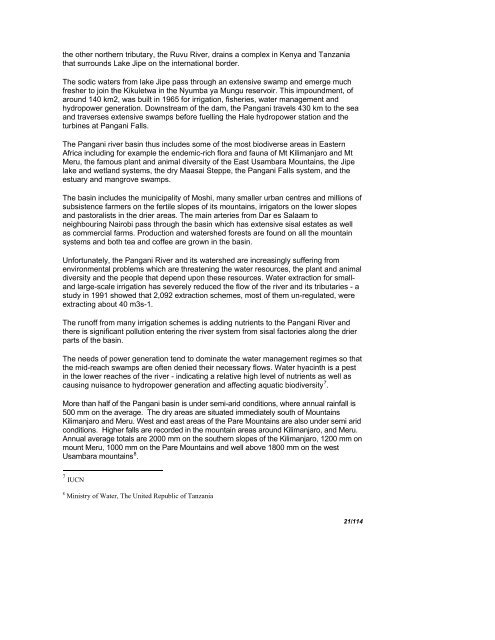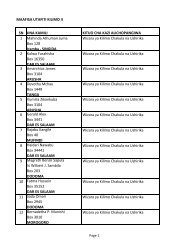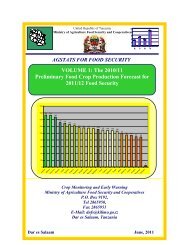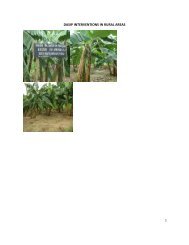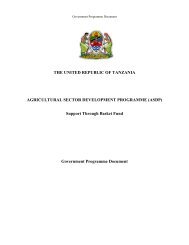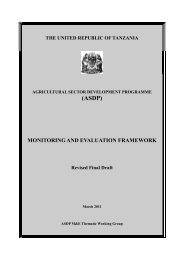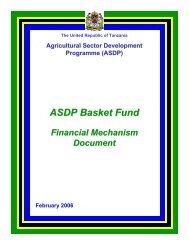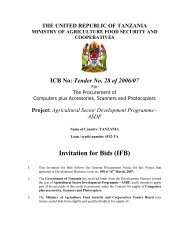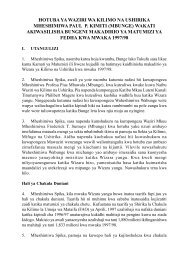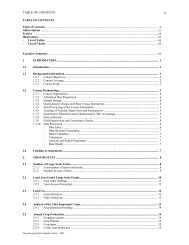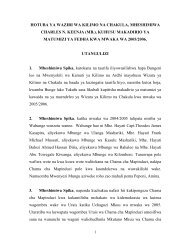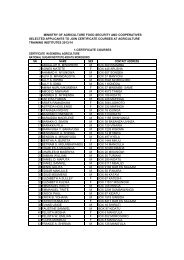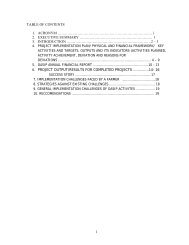ASDP: Environmental And Social Management Framework
ASDP: Environmental And Social Management Framework
ASDP: Environmental And Social Management Framework
- No tags were found...
You also want an ePaper? Increase the reach of your titles
YUMPU automatically turns print PDFs into web optimized ePapers that Google loves.
the other northern tributary, the Ruvu River, drains a complex in Kenya and Tanzaniathat surrounds Lake Jipe on the international border.The sodic waters from lake Jipe pass through an extensive swamp and emerge muchfresher to join the Kikuletwa in the Nyumba ya Mungu reservoir. This impoundment, ofaround 140 km2, was built in 1965 for irrigation, fisheries, water management andhydropower generation. Downstream of the dam, the Pangani travels 430 km to the seaand traverses extensive swamps before fuelling the Hale hydropower station and theturbines at Pangani Falls.The Pangani river basin thus includes some of the most biodiverse areas in EasternAfrica including for example the endemic-rich flora and fauna of Mt Kilimanjaro and MtMeru, the famous plant and animal diversity of the East Usambara Mountains, the Jipelake and wetland systems, the dry Maasai Steppe, the Pangani Falls system, and theestuary and mangrove swamps.The basin includes the municipality of Moshi, many smaller urban centres and millions ofsubsistence farmers on the fertile slopes of its mountains, irrigators on the lower slopesand pastoralists in the drier areas. The main arteries from Dar es Salaam toneighbouring Nairobi pass through the basin which has extensive sisal estates as wellas commercial farms. Production and watershed forests are found on all the mountainsystems and both tea and coffee are grown in the basin.Unfortunately, the Pangani River and its watershed are increasingly suffering fromenvironmental problems which are threatening the water resources, the plant and animaldiversity and the people that depend upon these resources. Water extraction for smallandlarge-scale irrigation has severely reduced the flow of the river and its tributaries - astudy in 1991 showed that 2,092 extraction schemes, most of them un-regulated, wereextracting about 40 m3s-1.The runoff from many irrigation schemes is adding nutrients to the Pangani River andthere is significant pollution entering the river system from sisal factories along the drierparts of the basin.The needs of power generation tend to dominate the water management regimes so thatthe mid-reach swamps are often denied their necessary flows. Water hyacinth is a pestin the lower reaches of the river - indicating a relative high level of nutrients as well ascausing nuisance to hydropower generation and affecting aquatic biodiversity 7 .More than half of the Pangani basin is under semi-arid conditions, where annual rainfall is500 mm on the average. The dry areas are situated immediately south of MountainsKilimanjaro and Meru. West and east areas of the Pare Mountains are also under semi aridconditions. Higher falls are recorded in the mountain areas around Kilimanjaro, and Meru.Annual average totals are 2000 mm on the southern slopes of the Kilimanjaro, 1200 mm onmount Meru, 1000 mm on the Pare Mountains and well above 1800 mm on the westUsambara mountains 8 .7 IUCN8 Ministry of Water, The United Republic of Tanzania21/114


